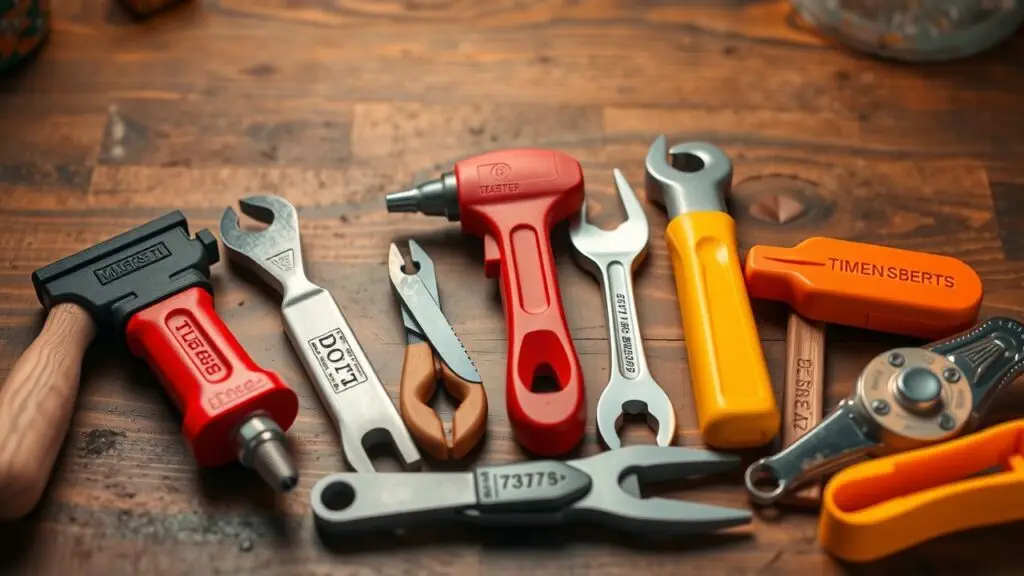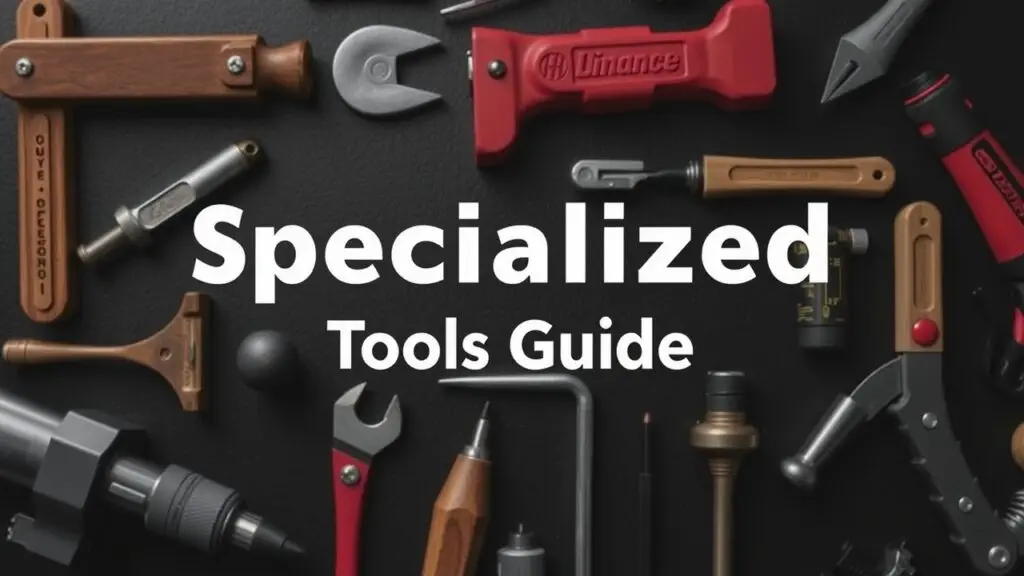Learn about different types of tools with this comprehensive list. We’ll show you many tools, with pictures and descriptions covering hand tools, power tools, and specialty tools to help you find the right tool for your task.
What Are the Different Types of Tools?

Tools are things we use to help us get jobs done better and faster. There are many types of tools, and each one has its own job. Knowing about these different types can help anyone working on projects at home or in a workshop.
Overview of Tool Categories
- Hand Tools: These are tools you use by hand, without needing power. Common examples include hammers, screwdrivers, pliers, and wrenches. You can use hand tools for simple tasks like fixing a loose screw or putting together furniture.
- Power Tools: Power tools need electricity or batteries to work. This group includes drills, saws (like circular saws), sanders, and grinders. While they can make tasks quicker, you must be careful because they can also be dangerous.
- Specialty Tools: These tools are made for specific tasks. For example, tile cutters are great for laying down floors, while pipe benders help with plumbing jobs.
- Measuring Tools: Getting the right measurements is super important in any project. Measuring tools like tape measures, levels, squares, and calipers help you ensure that everything fits just right.
- Cutting Tools: Cutting tools are used to cut different materials such as wood or metal. Examples include utility knives and chisels along with powered options like band saws.
- Drilling Tools: Drills make holes in various materials and are very useful in many projects. This group includes handheld electric drills and drill presses that you find in workshops.
Knowing the different types of tools helps you pick the right one for your job and keeps you safe while you work.
Why Is It Important to Use the Right Tool for a Job?
Using the right tool is key for getting good results and staying safe:
Consequences of Using Incorrect Tools:
- Using the wrong tool can lead to injuries. People can get cuts or even more serious harm.
- Damage can happen too, not just to what you’re working on but also to the tool if it’s not meant for that task.
Benefits of Proper Tool Selection:
- When you use the right tool, you get things done faster.
- You also get better accuracy, so your work turns out how you want it.
- Finally, using the right tool means fewer accidents happen.
In short, knowing about different types of tools and how to use them correctly leads to success in your projects and keeps everyone safer!
What Are Hand Tools?
Hand tools are tools that you operate by hand. They rely on your physical effort rather than machines. These tools are super important for many tasks like construction, woodworking, and plumbing. Hand tools come in a wide range, from simple ones like hammers to more detailed ones like pliers and screwdrivers. They help you work faster and more accurately on your projects.
Categories of Hand Tools with Examples
Hand tools can be grouped into several types based on how you use them:
- Striking Tools: This group includes hammers (like claw hammers and ball-peen hammers) and mallets. You use striking tools mainly to drive nails or break things apart.
- Turning Tools: Here, you find screwdrivers (such as Phillips and flathead), wrenches (like adjustable and socket), and pliers. Turning tools help you tighten or loosen fasteners easily.
- Measuring Instruments: Measuring is key to any project. Common measuring tools are tape measures (like steel tape measures) and levels (like spirit level and laser level). They help make sure your measurements are spot on.
- Cutting Implements: Saws (such as hand saws and hacksaws) and knives fall into this category. They are specially made for cutting materials such as wood or metal.
- Other Commonly Used Items: Files help shape materials while clamps hold items steady during work, making them very useful in many DIY tasks.
Best Practices for Using Hand Tools Safely
When using hand tools, keep these safety tips in mind:
- Always wear the right protective gear, such as gloves or goggles, to avoid injuries.
- Use the correct grip techniques to keep control of the tool while working.
- Take care of your hand tools by sharpening blades when needed and cleaning rust off surfaces for the best performance.
Using hand tools correctly not only makes your work easier but also cuts down on accidents that can happen if they’re used wrongly.
What Are Power Tools?
Power tools are devices that help people work faster and with more accuracy. They usually run on electricity or other sources like air pressure or hydraulic power. Knowing the key features of these tools can help you choose the right one for your tasks.
Types of Power Tools With Descriptions
There are several types of power tools based on what they do:
- Rotary Devices – This includes drills and grinders. These tools spin really fast to help you drill holes or smooth out surfaces.
- Reciprocating Equipment – Jigsaws and reciprocating saws move back and forth to cut through different materials easily. They’re great for making detailed cuts.
- Impact Machines – Impact drivers give more force than regular screwdrivers, making it easier to drive screws into tough surfaces.
- Additional Options – Sanders and nail guns are key for carpentry work where you need a nice finish or want to fasten parts together quickly.
Safety Precautions For Handling High Voltage-Powered Units
When using power tools that run on high voltage or pressure, follow these safety tips:
- Always put on personal protective equipment (PPE), like gloves and goggles.
- Get trained on how to use these tools safely.
- Check the cords and connections regularly for any damage before using them.
- Carefully read and follow the manufacturer’s instructions to avoid accidents.
Maintenance Tips for Power Tools
To keep your power tools working well for a long time, try these maintenance tips:
- Clean the outside after each use to get rid of dust and debris that could mess things up.
- Lubricate moving parts based on the manufacturer’s recommendations from time to time for smooth operation.
- Store your tools in a dry place away from moisture that might cause electrical problems.
Knowing about different types of power tools helps you pick the right one for your projects. Following safety rules boosts both productivity and safety in any workspace.
What are Specialized Tools?
Specialized tools are instruments made for specific tasks or industries. They boost efficiency and accuracy in various jobs. For example, in fields like automotive repair, plumbing, electrical work, woodworking, and welding, using specialized tools can lead to better results with less effort.
Categories of Specialized Tools with Examples
Specialized tools fit into different categories based on their use. Here are some types along with examples:
Automotive Tools:
- Adjustable wrenches loosen nuts and bolts.
- Socket sets come in various sizes for different fasteners.
- Torque wrenches ensure precise fastening during repairs.
- Diagnostic scanners help mechanics identify vehicle issues quickly.
Plumbing Tools:
- Pipe wrenches grip pipes without slipping.
- Pipe cutters make clean cuts on pipes of all sizes.
- Drain snakes clear blockages without damaging plumbing systems.
Electrical Tools:
- Multimeters measure voltage and current levels accurately.
- Wire strippers remove insulation safely from wires.
- Crimpers secure connectors firmly onto wires.
Woodworking Tools:
- Planes smooth wood surfaces for better finish.
- Jointers create flat edges for seamless joining of pieces.
- Lathes shape wood into cylindrical forms for furniture making.
Welding Tools:
- Welding torches generate heat needed to fuse metals together.
- Protective helmets shield welders’ eyes from sparks and UV rays.
- Grinding wheels refine metal surfaces after welding to give a polished look.
Safety Precautions for Specialized Tools
Using specialized tools means following safety rules specific to each field. Always wear personal protective equipment (PPE) like gloves and goggles when handling these tools. It’s good to read the manufacturer’s instructions for safe use and maintenance to avoid risks linked with each tool type.
Regular inspections of tools help prevent accidents due to faulty items. Keeping every tool safe for operation is key to a productive working environment.
How to Choose the Right Tool?

Choosing the right tools for your projects is key. Knowing the types of tools available and what fits your needs can make a big difference. This guide will help you find the best tools for your tasks.
Factors to Consider
When picking a tool for a job, several important factors come into play. These factors can greatly affect how well your work goes.
- Task: Start by figuring out what you need to do. Different tasks need different tools. Are you cutting, drilling, or fastening? Knowing this helps narrow down choices.
- Material: The material you’ll be using matters a lot. For example, wood requires saws made for cutting wood, while metal needs special tools designed for that purpose.
- Precision: Think about how precise your work has to be. Some jobs need accuracy, like when you’re putting in cabinets, so you’ll want tools that allow for fine control.
- Budget: Set a budget for how much you’re willing to spend on your tool. Don’t skimp on quality; investing in good tools can save money over time.
- Skill Level: Consider your own experience with different types of tools. Some power tools are tricky to use compared to hand tools, so choose what you’re comfortable with.
Decision-Making Process
Making a good decision on which tool to use involves some planning:
- Create a flowchart with questions about your task (like “Is this a cutting job?”).
- Add choices based on your answers (for instance, if it is cutting—look at saws or knives).
- Lead yourself from broad categories down to specific tool recommendations that fit your needs.
Examples of Tool Selection
Here are some examples to show how to select the right tool:
- Compare using a hand saw versus a power saw based on what you’re working on. A hand saw works great for smaller jobs, but a power saw is better for bigger cuts.
- Talk about when to use special screwdriver bits instead of regular ones based on the type of screws and how hard they are to reach.
- Look at when you need either standard wrenches or torque wrenches—this is important in car repairs where exact torque settings matter.
By thinking through these factors and following the decision-making process, DIY fans can pick practical tools that match their projects and lead to successful outcomes every time they work on home improvements or repairs.
Tool Safety and Maintenance: Best Practices and Prevention
Tool Safety Guidelines
Safety should always come first when using tools, both hand and power types. Start by keeping your workspace tidy. A clean area helps prevent accidents. Always wear the right personal protective equipment (PPE). This includes gloves, goggles, and ear protection to shield against injuries from flying debris or loud noises.
Before beginning any task, inspect your tools regularly. Check for signs of wear or damage that could lead to problems during use. It’s also key to follow the manufacturer’s instructions for safe operation. These guidelines tell you how to use each tool correctly.
Specific Safety Practices
Every tool has its own risks. For example, hand tools like chisels can cause cuts if not handled carefully. Power tools may pose electrical hazards if misused. To steer clear of common injuries from improper use—like cuts or electric shocks—stick to detailed safety practices for each type of tool.
Make sure you’re familiar with safety standards set by organizations like OSHA (Occupational Safety and Health Administration) and ANSI (American National Standards Institute). These rules help ensure safety in the workplace when using different types of equipment.
Tool Maintenance
Taking care of your tools can make them last longer and work better.
Cleaning Tools
Keep your workspace organized. A tidy area is safer because it reduces the risk of slips and falls around sharp objects. Clean both hand and power tools after each use. Remove dust, grease, and other materials that build up over time.
Lubrication Techniques
Regular lubrication is key. It helps cut down on friction and wear on moving parts. Use lubricants suited for each tool type—for instance, oil-based lubricants are good for saw blades, while silicone sprays work well on some mechanical devices.
Sharpening Methods
Sharp edges on cutting tools improve performance and lower injury risk since you won’t have to apply as much force with dull blades. Different sharpening strategies exist based on the design; chisels often need honing stones, while knives can benefit from whetstones or specific sharpening rods.
Storage Solutions
Good storage keeps tools safe from damage and allows for easy access during projects—a neat workshop boosts productivity too! Think about using pegboards to hang frequently used items within reach or mobile carts to keep everything organized yet portable across job sites.
Tool Repair
You can do basic repairs at home without needing a professional—for example, replacing worn cords in power drills is a straightforward task—but it’s crucial to know when to call an expert for more complex issues.
Inspection Frequency
How often you check your tools depends on how much you use them. Aim for regular checks on industrial devices every few months while household tools may only need an annual inspection unless they see heavy DIY action.
By following these tips for tool safety and maintenance, you’ll keep yourself safe while also ensuring your tools remain in great shape!
Frequently Asked Questions about Tool Selection and Maintenance
What tool brands are recommended for beginners?
Some reliable tool brands include DeWalt, Stanley, and Craftsman. These brands offer quality tools that cater to beginners. Look for tools with good warranties and positive reviews.
How can I find the best tool retailers?
Visit home improvement stores like Home Depot or Lowe’s for a wide range of tools. Online marketplaces such as Amazon also offer various brands and models. Check customer reviews before making a purchase.
What are the most popular power tools for DIY projects?
Popular power tools include cordless drills, circular saws, and jigsaws. These tools help complete tasks quickly and efficiently. They are essential for many home improvement projects.
Where can I find reliable tool manuals and guides?
Manufacturers often provide manuals on their websites. You can also find tool guides in home improvement books or reputable online forums dedicated to DIY projects.
What is the importance of tool maintenance?
Regular maintenance keeps tools in good working condition. It prevents accidents caused by faulty equipment. Proper care extends the life of your tools, saving you money over time.
How do I choose multi-purpose tools for my toolkit?
Multi-purpose tools save space and offer versatility. Look for combination wrenches, screwdriver sets with interchangeable bits, or pliers with multiple functions. These can handle various tasks effectively.
Additional Tools and Accessories
Tool Accessories:
- Drill bits improve drilling capabilities.
- Saw blades customize cutting options.
- Sanding discs provide smooth finishes.
Specialized Tools:
- Automotive repair tools include socket sets.
- Plumbing needs pipe wrenches and cutters.
- Woodworking requires chisels and planers.
Tool Safety Equipment:
- Wear safety glasses to shield eyes from debris.
- Use work gloves to avoid cuts during handling.
- Ear protection is crucial when using loud power tools.
Tool Organization Systems:
- Tool chests offer storage for various items.
- Pegboards keep frequently used tools accessible.
- Tool belts allow easy access to essential items during projects.
Cleaning Tools:
- Wire brushes remove rust from metal surfaces.
- Cleansing solutions help restore equipment functionality.
Measurement Instruments:
- Use tape measures for precise lengths.
- Levels help align objects correctly during installation.
By utilizing these tips, you can select effective tools tailored to your needs while maintaining them safely and efficiently.
Related Topics
- Types of hand tools
- Types of power tools
- Types of measuring tools
- Types of cutting tools
- Types of drilling tools
- Types of striking tools
- Types of turning tools
- Types of tool accessories
- Types of specialized tools
- Types of tool safety equipment
- Types of tool organization systems
- Types of cleaning tools
- Types of measurement instruments
- Types of screwdriver bits
- Types of saws
- Types of wrenches
- Types of pliers
- Types of hammers
- Types of knives
- Types of clamps
- Types of files
- Types of levels
- Types of drill bits
- Types of saw blades
- Types of sanding discs
- Types of automotive repair tools
- Types of plumbing tools
- Types of woodworking tools



Types of Tools: A Comprehensive List with Descriptions